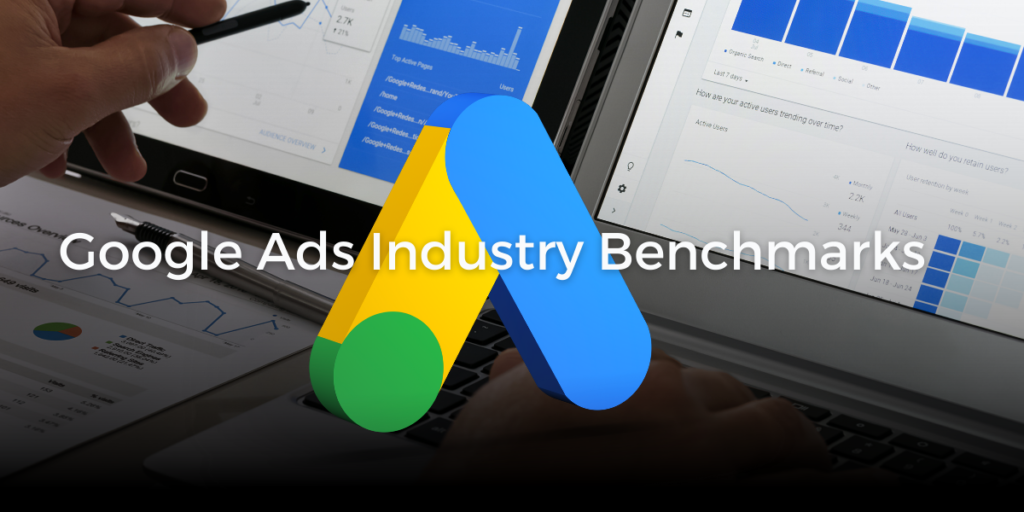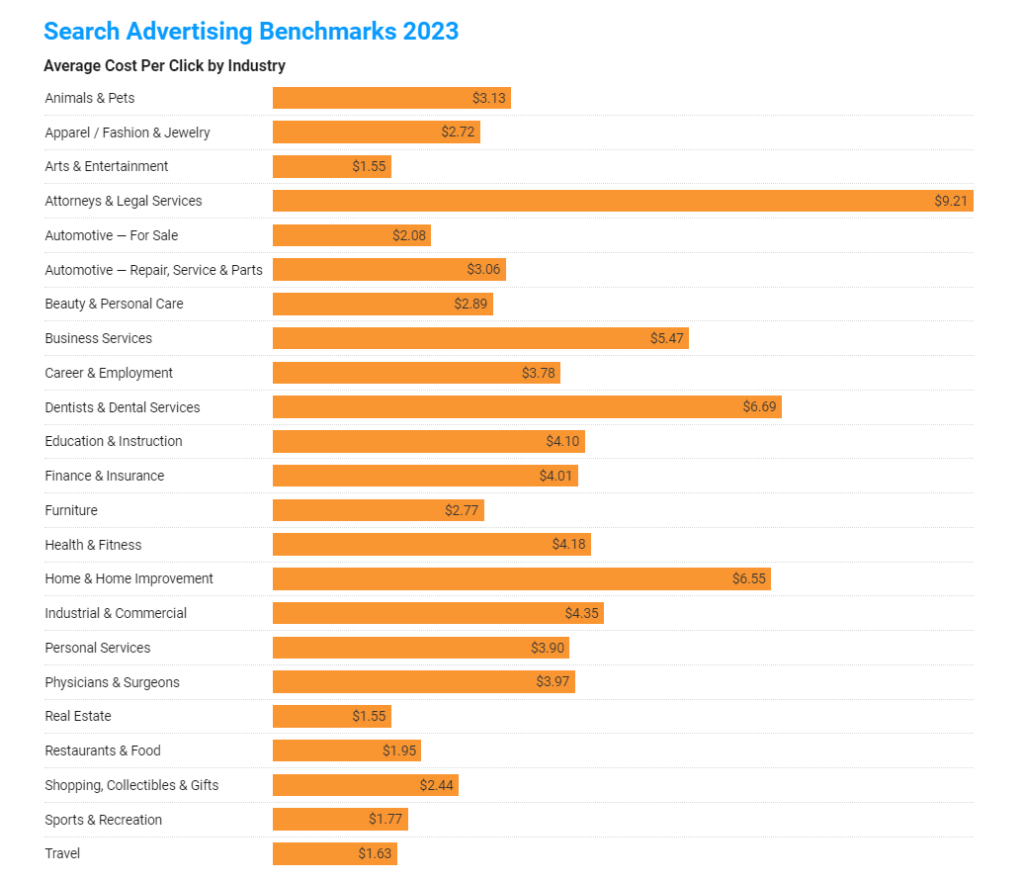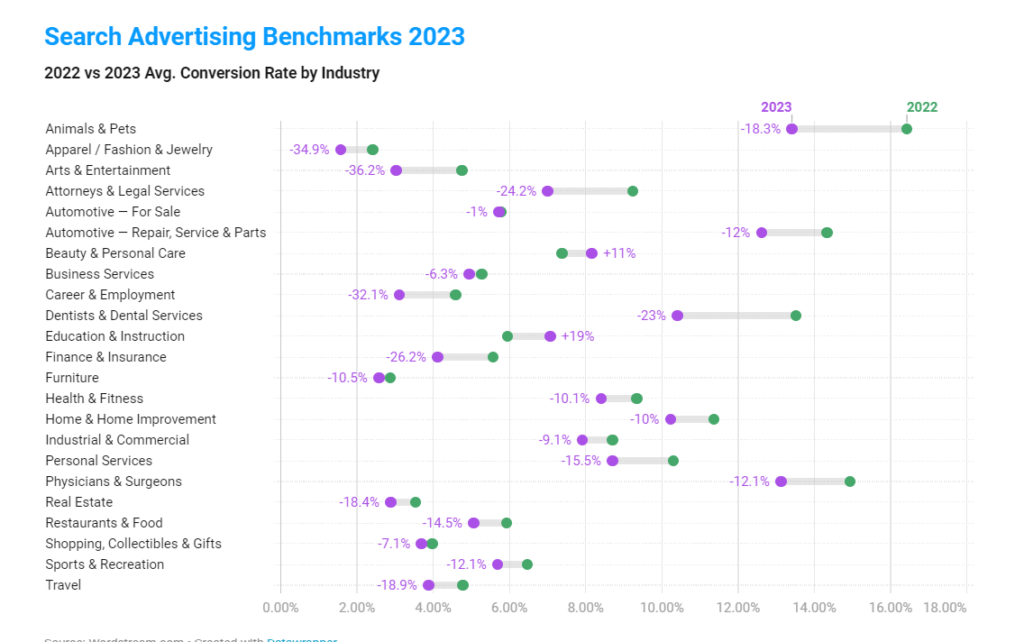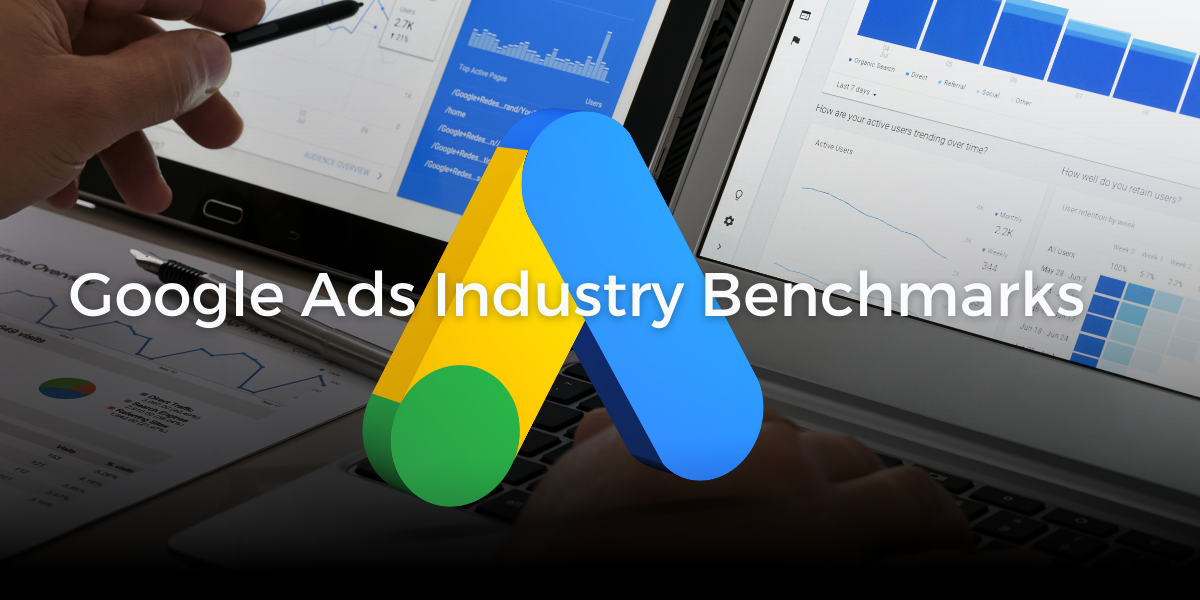
Knowing the Google Ads industry benchmarks is important if you use Google Ads to promote your business. These Google Ads industry benchmarks give you an idea of whether your strategy is working and how well your campaigns perform compared to other players in your industry.
Wordstream has compiled and updated Google Ads industry benchmarks based on data collected from US businesses covering twenty industries: Advocacy, Auto, B2B, Consumer Services, Dating and personals, E-Commerce, Education, Employment Services, Finance and Insurance, Health and Medical, Home Goods, Industrial Services, Legal, Real Estate, Technology, and Travel & Hospitality.
Table of Contents
- Search Ads Benchmarks Trends for Your Business
- Search Ads Benchmarks for Every Industry
- Average Click-Through Rate in Google Ads by Industry
- Average Cost Per Click In Search Ads
- Average Conversion Rates in Google Ads by Industry
- Average Cost Per Lead in Google Ads by Industry
- Why are Search Ads Benchmarks and Trends Important for Your Business
- Final Thought
Search Ads Benchmarks Trends for Your Business
- Click-Through Rate (CTR): The data indicates that Click-Through Rates have generally increased year over year (YoY) for the majority of industries, with 21 out of 23 sectors experiencing growth. Even though the Business Services and Industrial and Commercial sectors saw minor decreases, the declines were comparatively mild compared to the substantial increases seen in other industries.
This trend highlights the importance of staying competitive in ad performance. For instance, with your recent ad campaign optimization efforts, your CTR increased by 12%, outpacing the industry average of 8%. This demonstrates that your strategies are effectively capturing user attention.
- Cost Per Click (CPC): The provided data reveals that CPC has risen YoY for 61% of industries, signaling an overall industry trend of increasing advertising costs. However, it’s worth noting that 35% of industries experienced CPC decreases, and one sector, Apparel, Fashion, and Jewelry, maintained a steady CPC.
While the industry trend leans toward higher CPCs, you’ve managed to reduce your CPC by 10% through refined keyword targeting and improved Quality Scores. This prudent approach allows you to maintain competitiveness even in the face of rising costs.
- Conversion Rate (CVR): Conversion rates have experienced YoY declines across most industries, with significant drops seen in many cases. Only the Beauty and Personal Care and Education and Instruction sectors managed to maintain or slightly improve their conversion rates.
To address the declining CVR, you’ve implemented a comprehensive A/B testing strategy, resulting in a 15% improvement in your conversion rate. This strategic move allows you to offset the increase in Cost Per Lead (CPL) that often accompanies a reduced CVR.
- Cost Per Lead (CPL): The data underscores that CPL has increased YoY across all industries except for Automotive Sales and Beauty and Personal Care. This suggests that 91% of industries witnessed an uptick in lead acquisition costs through search ads. However, the latest updates for 2023 show that these YoY increases have begun to slow down.
Your proactive approach to CPL management, similar to the Automotive Sales and Beauty and Personal Care sectors, has helped maintain stable CPL figures over the past year, despite the industry-wide trend of rising CPL.

Source: WordStream.com
Search Ads Benchmarks for Every Industry
Here are the combined industry benchmarks for Microsoft Ads and Google Ads for all four KPIs to begin our data exploration.
After examining the combined industry benchmarks for Microsoft Ads and Google Ads across all four KPIs, it’s important to note the recent new features of Microsoft Ads, which offer enhanced targeting and analytics capabilities to further optimize advertising strategies.

Source: Wordstream.com
Average Click-Through Rate in Google Ads by Industry
Your average click-through rate serves as a significant indicator of the effectiveness of your search ad quality. When you have a higher ad rank coupled with compelling ad copy, you are more likely to attract a greater number of clicks, which in turn, plays a pivotal role in driving conversions.
To calculate your average click-through rate, you divide the total number of clicks by the total number of impressions.
As of 2023, the average click-through rate in Google Ads stands at 6.11%.


Source: Wordstream.com
Industries with the lowest click-through rates include Attorneys and Legal Services, registering at 4.76%, Home and Home Improvement at 4.80%, and Business Services at 5.11%.
On the flip side, the sectors with the highest click-through rates were Arts and Entertainment, boasting an impressive 11.78%, Sports and Recreation with 10.53%, and Travel at a noteworthy 10.03%.
Average click-through rate: YoY
Here’s how click-through rates have changed in 2023 compared to 2022:

Source: Wordstream.com
In the latest year-over-year comparison, the Business Services industry experienced a notable decline in average click-through rates, decreasing by 2.11%. Similarly, the Industrial and Commercial sectors saw a reduction in click-through rates, dropping by 1.94%.
Conversely, the Sports and Recreation industry witnessed a significant rise in click-through rates, showing an increase of 17.65%. Shopping, Collectables, and Gifts sectors also observed a notable uptick, with an increase of 15.55% in click-through rates. Additionally, the Beauty and Personal Care industry experienced a boost in click-through rates, growing by 15.08% over the same period.
Average Cost Per Click In Search Ads
The average cost per click (CPC) in Google or Microsoft Ads is determined by dividing the total expenditure of a campaign by its total number of clicks. Clicks are crucial in search campaigns, bringing potential customers from an ad to a landing page.
Each click incurs a unique cost, calculated on the spot by Google Ads’ auction algorithms, making the average CPC a useful metric for shaping bidding strategies, ad copy, budgets, and more.
Accounts with higher click-through rates (CTR) often enjoy lower CPCs, as increased clicks compensate for the total spend. However, this isn’t always consistent due to factors like intense industry competition.
For 2023, the average CPC in Google Ads stands at $4.22, illustrating the cost variance across different industries.


Source: Wordstream.com
Average Cost Per Click: YoY
Let’s see how the above cost-per-click numbers compare to last year’s data:

Source: Wordstream.com
This year, cost per click increased in more industries (61%) than it did the previous year (57%). The three categories with the largest annual cost increases were real estate (up 12.32%), furniture (up 12.6%), and personal services (17.47%).
On the other hand, compared to the previous year, several industries saw significant cost-per-click savings this year. For instance, with an 11.48% decrease, Finance and Insurance saw the greatest decline in cost per click. Similarly, auto sales had an 8.37% decrease in average cost per click, while dentists and dental services saw a 7.60% decrease.
Average Conversion Rates in Google Ads by Industry
The average conversion rate is a crucial metric in assessing the effectiveness of your campaigns. It is calculated by dividing the total number of conversions by the total number of clicks.
A higher conversion rate can offset costs per lead, directly impacting your company’s profitability. As Colarossi points out, the conversion rate is perhaps the most vital metric to measure the success of PPC campaigns. It provides essential insights into how effectively a campaign is converting leads into customers, which is the primary goal for most of these campaigns.
A high conversion rate indicates that a campaign is successfully engaging its target audience and compelling them to take the desired action. Given its significance, investing in a Conversion Rate Optimization (CRO) service becomes crucial for enhancing these rates and, subsequently, the success of your PPC campaigns.
The average conversion rate in Google Ads in 2023 is 7.04%.


Source: Wordstream.com
At 1.57%, Furniture at 2.57%, Real Estate at 2.88%, and Apparel, Fashion, and Jewelry at 1.57% were the three industries with the lowest average conversion rates.
The three sectors with the highest average conversion rates were Automotive Repair, Service, and Parts (12.61%), Physicians and Surgeons (13.2%), and Animals and Pets (13.41%).
Average conversion rate: YoY
Now, take a look at conversion rates year over year:

Source: Wordstream.com
Over the past year, the categories experiencing the most significant drops in average conversion rates were Career and Employment (down 32.04%), Apparel, Fashion, and Jewelry (down 34.78%), and Arts and Entertainment (down 36.22%). In contrast, Education and Instruction saw the largest increase in conversion rate, rising by 18.86% year over year, with Beauty and Personal Care close behind at a 10.76% increase.
Despite these changes in conversion rates, Elisa Gabbert, Director of Content and SEO at LocaliQ, isn’t surprised by the decline in some sectors. She explains that ads are often displayed in response to more informational queries rather than commercial ones. This trend can lead to higher click-through rates (CTRs) but lower conversion rates, as not all searchers have the intent to convert.
Average Cost Per Lead in Google Ads by Industry
For many advertisers, the cost per lead is considered the crucial ‘money metric.’ This metric is calculated by dividing the total amount spent on a campaign by the total number of conversions it yields. Essentially, it measures the efficiency of your PPC advertising expenditure in terms of the ‘bang for your buck.’
In 2023, the average cost per lead for Google Ads is projected to be $53.52


Source: Wordstream.com
Career and Employment ($132.95), Attorneys and Legal Services ($111.05), and Furniture ($108.85) were the three industries with the highest cost per lead.
At $21.12, Automotive Repair, Services, and Parts, Animals and Pets, at $23.57, and Shopping, Collectibles, and Gifts, at $31.50, were the industries with the lowest cost per lead.
Cost Per Lead On Average: YoY
As most industries have seen increases in average cost per lead this year, let’s examine how this trend compares to the previous year:

Source: Wordstream.com
The industries with the largest year-over-year increases in CPL were Real Estate (up 46.22%), Arts and Entertainment (up 49.18%), and Career and Employment (up 52.19%).
Considering the state of the economy, this is not surprising. “Digital campaigns across multiple industries are being impacted by the recent increase in interest rates. Although interest rates are at their highest point since 2008, Mark Irvine, Director of Paid Media at SearchLab, noted that the digital environment in 2023 is unlike anything seen when advertisers ran their campaigns with high-interest rates. “Loans frequently drive and finance the largest purchases a typical consumer makes, including real estate, banking, and education. Customers will take more time to investigate and consider these choices because they are significant ones.
Why are Search Ads Benchmarks and Trends Important for Your Business
Search Ads Benchmarks and Trends play a pivotal role in the success of your business’s digital advertising efforts for several reasons, and understanding Google Ads industry benchmarks is a key part of this process.
Furthermore, being aware of common Google Ads mistakes that will ruin your account is essential to avoid pitfalls and maximize the effectiveness of your campaigns.
Here’s why they are crucial for your business:
The Way Customers Search Is Evolving Quickly
The declining average conversion rate in 91% of industries suggests a shift in the buyer’s journey, with consumers becoming more cautious due to economic factors like inflation. This caution leads to more deliberate purchasing decisions, contributing to lower conversion rates despite higher click-through rates. According to Irvine, search advertisers must recognize the broader context of their prospects’ searches, as the cost implications now extend beyond the initial ad impression.
Furthermore, the diverse digital landscape allows potential customers to engage with businesses across various channels before making a purchase. This indicates that while search advertising may capture early-stage interest, other marketing strategies are needed to guide these prospects toward conversion.
Additionally, the use of Google Ads for small businesses is becoming increasingly important in this diverse digital landscape, offering targeted and cost-effective solutions for engaging with potential customers across different stages of their buying journey.

Source: Wordstream.com
Data-Driven Decision-Making
Search Ads Benchmarks and Trends provide you with a wealth of data and statistics specific to your industry and competitors. By analyzing this information, you can make informed decisions about your advertising strategy. For instance, understanding that your industry’s average Click-Through Rate (CTR) is 3.17% allows you to set realistic performance goals and gauge the effectiveness of your campaigns.
Tracking and Reporting are Crucial
This report highlights the importance of effective Google Ads reporting and tracking for business success. Keeping up with industry benchmarks and comparing your performance against competitors is key.
Brett McHale, a Paid Media Marketing Expert and Founder of Empiric Marketings emphasizes the need to focus on performance metrics that are most relevant to your business. He explains that even with a high cost per click, you can achieve an optimal lead cost if your conversion rate is high. This demonstrates the value of optimizing for metrics that align with your business strategy.
He also advises concentrating on structuring your account and campaigns to meet your PPC advertising goals. Prioritizing metrics that support these goals can significantly improve PPC (Pay-Per-Click) results.

Jackson says that reports like this one, along with looking at your own ad account and goals, can help you make smart marketing choices based on data. She notes that it’s important to keep an eye on things like how much you pay for each click and how many people click on your ads. However, these shouldn’t be the only things you focus on, because good numbers in these areas don’t always mean your ads are giving you the profit you want. But, they are useful for making your ads better.
Smith agrees and adds that in digital ads, knowing how much each click costs, how often people click your ads, how many of those clicks turn into customers, and how much you pay for each customer are all important. By keeping track of these things, you can figure out which ads work best and change your plan to make your ads do even better. This way, you can get more out of your ads and meet your business goals more effectively.
Recent Updates To Search Campaigns Have Made Ads More Clickable
The rise in click-through rates across nearly all industries indicates a growing tendency for people to engage with ads. This increase can be attributed to platform enhancements such as making responsive search ads the default, the introduction of additional ad assets, and ads blending more seamlessly with organic results on Google’s interface. To remain competitive, advertisers need to focus on optimizing ad copy and utilizing various ad assets.
Saskin Gales also credits new ad formats for the spike in CTR, suggesting that advertisers are effectively using automated solutions like Performance Max and dynamic search ads to present more engaging and relevant content to their audiences.

Budget Allocation
As average costs per lead and click rise across most industries, efficiently managing a limited Google Ads budget becomes increasingly challenging. Advertisers need to invest wisely to keep up with these escalating costs. Flexible budgeting is key to success in cost-per-click and lead metrics. By being prepared to adjust the budget according to specific needs and market trends, advertisers can maximize the effectiveness of their campaigns.
Stephanie Scanlan, Vice President of Client Success at LocaliQ, emphasizes the necessity of proper budgeting for campaign success. She highlights the importance of having an adequate budget to compete effectively in ad auctions, emphasizing that without it, other aspects like website quality, keyword optimization, and ad text become secondary.
To maintain a dynamic budget strategy, it’s advisable to use spend-tracking tools like the Google Ads budget report or the LocaliQ Marketing Dashboard, which assist in monitoring budget allocation across different campaigns.

Final Thought
So, which industry converts the best online? The answer is dating and personals! That’s how popular online dating has gotten. After dating and personals, we have legal, which should be comforting for people who are spending all that money on the cost-per-click.
Don’t let these statistics demotivate you. They are here so that we can have guidelines on whether the strategy is working or if we need to do some optimization. We have seen CTRs skyrocket with our clients, while effectively decreasing their cost-per-click. With an effective strategy and an experienced eye to audit your campaigns, it’s possible!
If you’re not sure where to start, or if you’ve been managing your PPC campaigns but aren’t seeing the results you want, PPC management services can help. Services can range from optimizing your existing campaign to complete management of your PPC account.
Where do you stand in regard to your industry benchmarks? We would love to chat and discuss Google Ads industry benchmarks!


